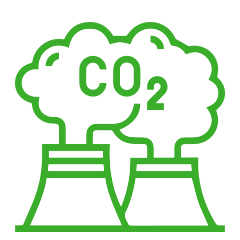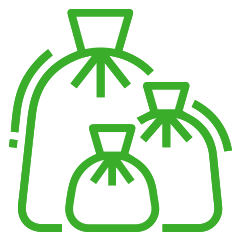Going deeper underground
Geoexchange pipe installation in Winnipeg
- May 07, 2024
- Environmental
CARBON EMISSIONS AND CLIMATE CHANGE
The Mint is committed to investing in solutions that reduce our carbon footprint, improve waste diversion and minimize the environmental impact of our operations.


As a Crown corporation working to serve Canadians, we must lead by example to minimize our environmental impact. That’s why the Mint’s Board directed us to prioritize our environmental efforts on reducing our carbon emissions. Our leading near-term goal? To have a carbon-neutral Circulation Business by 2030.
Looking longer-term, we completed an inventory of our Scope 3 GHG emissions sources in 2024. Scope 3 emissions include emissions linked to our supply chain, from raw materials used in minting and refining processes, to emissions related to transportation, as well as other requirements to manufacture finished products.
This external assessment of all GHG emissions, including a materiality assessment of Scope 3 emissions, was conducted and validated by expert third parties. This work has helped the Mint to develop science-aligned carbon emission reduction targets for the near and long-term.
Carbon Emissions and Climate Change

The Mint has made a commitment to have a Carbon Neutral Circulation Business by 2030, and has implemented a multi‑year, strategic Decarbonization Roadmap. This means that improvements to the operation of our Winnipeg facility will ensure that Canadian circulation coins, as well as those produced for other countries, are carbon neutral.

The Mint is focused on reducing carbon emissions through our entire value chain, including those from suppliers as well as our own transportation and business travel.
ISO 14001:2015 certification is required by many central banks and international clients to ensure the Mint has suitable environmental management systems in place. The Mint’s facilities in Ottawa and Winnipeg are both ISO 14001:2015 certified.
The Mint continues to search for new ways to divert more waste from going to landfills, while establishing waste diversion and recycling targets and key performance indicators (KPIs) for our manufacturing waste.
The Mint is focused on reducing everyday waste at its locations through both organization and employee initiatives. Recently, employees found a waste reduction opportunity at the Mint’s Ottawa warehouse. Their efforts saw over 21,000 kilograms diverted from landfill in 2024.
The Mint is identifying and implementing water consumption reduction opportunities to achieve a goal of 5% reduction over three years (2024‑2026).
The Mint is working collaboratively with other international Mints to identify opportunities to reduce the environmental footprint related to the packaging of our numismatic, circulation, and investment products.
Not only does the Mint produce all of Canada’s circulation coins, it also manages the national coin supply. From weekly forecasting, to production, recirculation and eventual retirement, our end-to-end oversight of inventories across the country enables us to effectively deliver a reliable and accessible payment option for all Canadians.
In any given year, the Mint is able to access and leverage coins already in circulation to meet financial institution coin demand. Typically, more than 85% of annual financial institution demand is met this way, limiting new coin production volumes to the minimum required. Other key elements of the Mint’s sustainability initiatives are our coin recycling recirculation and redistribution programs, which have reduced the average annual new coin requirements to support trade and commerce.
To further reduce our Scope 3 emissions and overall environmental footprint, the Mint completed trials to produce circulation coins from recycled steel, which reduces the need for new steel manufactured from iron ore. Following successful trials, the Mint plans to expand its use of recycled steel for both Canadian and international circulation coins.

In early 2025 the Mint announced plans to explore a collaboration with Enim Technologies Inc. (enim), an innovative company based in Quebec that specializes in ‘urban mining’ - the revalorization of precious metals and critical strategic minerals from obsolete electronic devices. Areas being explored include the feasibility of incorporating enim’s revalorized metals — including gold, silver, and copper — into the Mint’s future coin production, alongside the exchange of expertise in related strategic fields.
This section includes news and stories showcasing sustainability stories and initiatives at the Mint. Check back regularly for new features.



Begin implementation of Winnipeg Decarbonization Roadmap actions (phase 1 of 5).

Increase the Mint’s corporate waste diversion rate to 55%.

Implement water consumption reduction opportunities to achieve a 5% reduction over three years
(2024 – 2026).

Initiate supplier engagements for material Scope 3 greenhouse gas emissions, and align to SBTi (Science Based Targets) requirements.

Major environmental incidents are defined as involving a release into the natural environment that results in remediation, property damage, or enforcement action.


We are committed to acting responsibly by minimizing our impact on the environment, cultivating safe and inclusive workplaces and making a positive difference in the communities where we operate.